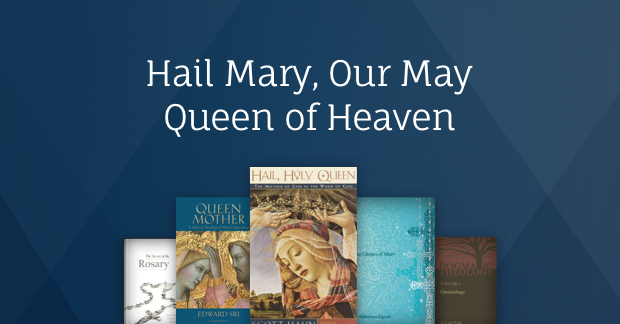There is a long tradition in the Church of praying Sacred Scripture—known as lectio divina (“divine reading” or “holy reading”)—as a privileged way of pondering God’s word in our hearts.
In his excellent book, Hans Boersma asserts that “Lectio divina simply means reading the Bible the way it’s supposed to be read—as divine Scripture.”1
In this article, I would like to advance the position that we imitate our Lady when we approach the Bible as God’s inspired word. In what follows, I begin with a consideration of Mary as our model of faith and then consider step by step how the Evangelist Luke’s account of the Annunciation (Luke 1:26–38) can serve as a narrative icon of the dialogue with God that takes place during lectio divina.2
Both St. John Henry Newman and Pope Bendict XVI serve as primary interlocutors in unfolding this vision of Mary and lectio divina.
Mary our model
Newman once noted that, despite the scarcity of passages in the Gospels about the Blessed Virgin Mary, nonetheless the Evangelists portray her as a model or pattern of the virtue of faith.
Commenting on the account given of Mary in the opening chapters of Luke’s Gospel, he observed that, “Mary’s faith did not end in a mere acquiescence in Divine providences and revelations: as the text informs us, she ‘pondered’ them.”
Throughout her life, Mary pondered the word of God. When we read about the visit of the shepherds, and how they declared to the Holy Family all that was revealed to them about the birth of Christ, we are told that Mary “treasured up all these things, pondering them in her heart” (Luke 2:19).
Years later, when Mary and Joseph found Jesus among the teachers in the Temple and questioned him about his actions, we are again told that Mary “treasured up all these things in her heart” (Luke 2:51).
Mary is presented to us as one who holds close and turns over in her heart the words revealed about her son and those spoken by her son.
Newman is right, then, to observe that “St. Mary is our pattern of Faith, both in the reception and in the study of Divine Truth. She does not think it enough to accept [God’s Word], she dwells upon it.”3
Mary dwells upon God’s revelation, pondering it in her heart. Pope Benedict XVI observes that “Mary appears [to us in Scripture] as a woman completely open to the will of God. … A Virgin ever attentive to God’s word, she lives completely attuned to that word; she treasures in her heart the events of her Son, piecing them together as if in a single mosaic.”4
She is our pattern or model of faith because of her receptivity to what the Lord reveals to her. Benedict XVI continues, “Mary also symbolizes openness to God and others; an active listening … in which the word becomes a way of life.”5
Thus, Mary of Nazareth is the model disciple, one who actively listens to God’s word and thereby is transformed.
A careful consideration of the life of our Lady shows us “how to be shaped by the working of God within us,”6 how to ponder God’s word in our hearts, to make God’s word our word, and thereby to conform our lives to that word.
By returning to the humble dwelling in Nazareth, we can discover in the Blessed Virgin Mary that “attentive hearing” of the word of God that bears abundant fruit. Indeed, Mary reveals what it is to be good soil for the Word of God, to be among those “who, hearing the word, hold it fast in an honest and good heart, and bear fruit with patience” (Luke 8:15).
Now let’s break down the Annunciation scene in Luke to show how its stages correspond to that of lectio divina.
1. Lectio (“Reading”)
In the sixth month the angel Gabriel was sent from God to a city of Galilee named Nazareth, to a virgin betrothed to a man whose name was Joseph, of the house of David; and the virgin’s name was Mary. And he came to her and said, “Hail, full of grace, the Lord is with you!” But she was greatly troubled at the saying, and considered in her mind what sort of greeting this might be. (Luke 1:26–29)
The first movement of lectio divina is the lectio itself, the reading of God’s word. The scene opens with Mary, alone in her home in Nazareth. And suddenly she is greeted by the angel of the Lord. Mary first hears the word of God; her posture is one of receptivity. She receives this word with loving attention, albeit not without some puzzlement and concern.
For us, when we read a passage of Scripture, we must first ask: “What does the biblical text say in itself?”7
What is it that God is saying? What is happening?
Here it can prove fruitful to read and re-read the sacred text a number of times. Furthermore, we might also read the text aloud, in order to hear more clearly what it is God is saying in his inspired word.
2. Meditatio (“Meditation”)
And the angel said to her, “Do not be afraid, Mary, for you have found favor with God. And behold, you will conceive in your womb and bear a son, and you shall call his name Jesus. He will be great, and will be called the Son of the Most High; and the Lord God will give to him the throne of his father David, and he will reign over the house of Jacob forever; and of his kingdom there will be no end. ” And Mary said to the angel, “How can this be, since I have no husband?” (Luke 1:30–34)
Having listened to God’s word, we then ponder it in our hearts, we meditate on Scripture. Consider how Gabriel here addresses our Lady by name, “Do not be afraid, Mary, for you have found favor with God.” Mary hears the word of God not in the abstract, but as a personal word. This is a word addressed specifically to her, in this time and place.
So too we should approach the Scriptures, confident that God wills to speak to each one of us personally, by name, through his inspired word.
In meditation, we ask: What does the biblical text say to me, here and now? Like Mary, we wrestle with that word, seeking to understand more fully what it means: “How can this be?” she asks.
Having heard the word of God, we ponder it in our hearts and ask: What does this mean in my own life? In meditation, “each person, individually but also as a member of the community, must let himself or herself be moved and challenged”8 by the inspired word.
3. Oratio (“Prayer”)
Next comes the divine messenger’s response to Mary’s pondering and her subsequent act of faith:
And the angel said to her, “The Holy Spirit will come upon you, and the power of the Most High will overshadow you; therefore the child to be born will be called holy, the Son of God. And behold, your kinswoman Elizabeth in her old age has also conceived a son; and this is the sixth month with her who was called barren. For with God nothing will be impossible.” And Mary said, “Behold, I am the handmaid of the Lord; let it be to me according to your word.” (Luke 1:35–38)
Now we find Mary’s oratio, her prayer, her faithful response to the divine word that blossoms forth from a heartfelt pondering of the divine message. “Behold I am the handmaid of the Lord; let it be to me according to your word.” Mary’s fiat, her response of faith, is the fruit that springs forth from her attentive hearing.
So too, having pondered what God is saying to us in the sacred text by meditating upon it, we then move to consider: What do I now say to the Lord in response to his word?9
As St. Augustine reminds us: “When you read the Bible, God speaks to you; when you pray, you speak to God.”10 Having first listened to God’s word and pondered it in our hearts, seeking to understand God’s will for our lives, we then respond to that word in prayer.
4. Contemplatio (“Contemplation”)
The story of the Annunciation ends somewhat abruptly; after hearing Mary’s response, we read simply:
And the angel departed from her. (Luke 1:38)
Mary again finds herself alone in her home in Nazareth. Well, not quite alone. “Since Mary is completely imbued with the word of God, she is able to become the Mother of the Word Incarnate.”11
Mary so opened herself up to receive the word of God that the Word becomes flesh in her womb.
The fourth and final step of lectio divina is contemplation. Following our prayerful response to God’s word, we are invited to take up God’s “own way of seeing and judging reality. … Contemplation aims at creating within us a truly wise and discerning vision of reality, as God sees it, and at forming within us ‘the mind of Christ.’”12
Following the angel Gabriel’s arrival, Mary’s reality is changed. Having received the divine word into herself, she is no longer who she was before this encounter. God’s Word has borne fruit in her life. Mary sees the world anew; she sees herself anew, as God sees her: not a lowly peasant girl from an unknown town, but “full of grace,” the “Mother of my Lord,” and even the Queen of Heaven.
So too we are changed through our prayerful encounter with God in his word. What conversion of mind, heart, and life is the Lord asking of me? How does my encounter with God in his inspired word prove to be an “encounter … which gives [my] life a new horizon and a decisive direction”?13
5. Actio (“Action”)
While the traditional four steps of lectio divina reach their summit in contemplation, many have recognized that a transformative encounter with God’s word bears fruit in the lives of our neighbors. As Pope Bendict XVI puts it, “We do well also to remember that the process of lectio divina is not concluded until it arrives at action … which moves the believer to make his or her life a gift for others in charity.”14
The story of the Annunciation doesn’t really end with the angel departing from Mary. Having heard the good news that her cousin Elizabeth is with child, Mary in turn acts:
In those days Mary arose and went with haste into the hill country, to a city of Judah, and she entered the house of Zechariah and greeted Elizabeth. … And Mary remained with her about three months, and returned to her home (Luke 1:39, 56).
Mary models for us that self-emptying love of others that marks the lives of the saints. In the Blessed Virgin, we can recognize the deep truth that “the most profound interpretation of Scripture comes precisely from those who let themselves be shaped by the word of God through listening, reading and assiduous meditation.”15
The saints are living interpretations of God’s word. Their lives serve as portraits of the rich, abundant fruit that is borne from drawing near to the Lord in word and sacrament.
In the Virgin Mary, we find not only a “model believer,” but also an “image of the Church,” of what all the baptized are called to be, precisely through the way that she “keeps God’s word in her heart and passes it on to others.”16
May we look to Mary in the Annunciation as a model of how the Lord comes to us through Sacred Scripture and how we in turn respond to the Lord in faith.
The Lectio Divina Workflow in Verbum
To practice lectio divina is to seek an encounter with God in his word, to imitate our Lady and attentively listen to that word, to hear God’s word addressed to each of us personally, pondering it in our hearts, responding to it in prayer, and resting in the presence of the Lord who comes to meet us.
For those who may be new to lectio divina, the Lectio Divina Workflow in Verbum can be a great way into this discipline of praying with Scripture.
The Lectio Divina Workflow provides a helpful step-by-step approach to praying through a selected passage from the Bible, and allows you to take digital notes along the way to track the fruit of your meditation and prayer.
As the description of this workflow suggests, it “works well when coupled with a systematic reading plan that directs you to a brief daily passage for reading and reflection, such as a lectionary or a devotional with a Bible reading plan.”
For newcomers, I would highly suggest taking the Gospel passage from the Lectionary and making that your chosen text for prayer each day. This can be a helpful way to integrate the use of Bible study software and your prayer life.
And in light of the above consideration, I would also suggest adding one small step at the end of your time working through the Lectio Divina Workflow: write down a succinct, actionable resolution for the day ahead.
Like Mary, hasten to bear fruit in charity.
Further resources on lectio divina
Piercing the Clouds: Lectio Divina and Preparation for Ministry (Catholic Theological Formation Series)
Price: $19.99
- Hans Boersma, Pierced by Love: Divine Reading with the Christian Tradition (Bellingham, WA: Lexham Press, 2023), 1.
- John Henry Newman, “Sermon 15: The Theory of Developments in Religious Doctrine,” Oxford University Sermons, https://www.newmanreader.org/works/oxford/sermon15.html.
- Newman, “Sermon 15.3,” Oxford University Sermons.
- Pope Benedict XVI, Verbum Domini, 27.
- Pope Benedict XVI, Verbum Domini, 27.
- Pope Benedict XVI, Verbum Domini, 28.
- Pope Benedict XVI, Verbum Domini, 87.
- Pope Benedict XVI, Verbum Domini, 87.
- See Pope Benedict, Verbum Domini, 87.
- Cited in Pope Benedict XVI, Verbum Domini, 86.
- Pope Benedict XVI, Verbum Domini, 28.
- Pope Benedict XVI, Verbum Domini, 87.
- Pope Benedict XVI, Deus Caritas Est, 1.
- Pope Benedict XVI, Verbum Domini, 87.
- Pope Benedict XVI, Verbum Domini, 48.
- Pope Benedict XVI, Jesus of Nazareth: The Infancy Narratives (New York: Image, 2012), 125–26.






